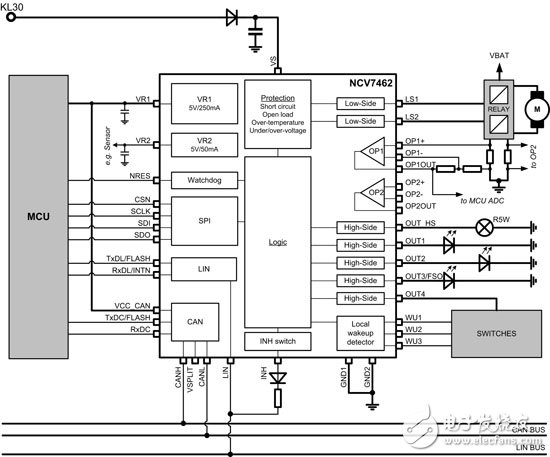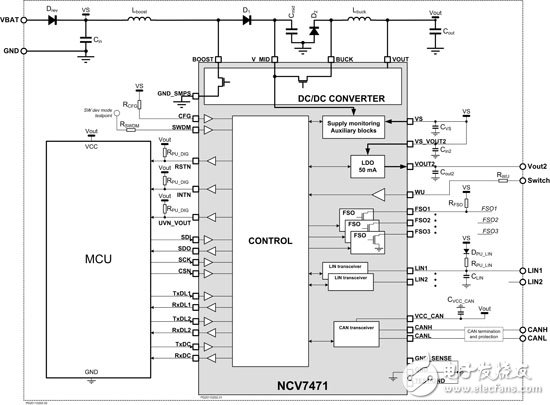Author: ON Semiconductor Jan Polfliet, Wim Van de Maele, Roman Buzas
For traditional passenger cars, the fuel tank is the only real source of energy, so manufacturers are looking to save energy in all automotive systems, including electronic systems, to further improve fuel economy and carbon dioxide (CO2) emissions. As the number of electronic systems added to automobiles continues to increase to enhance vehicle performance and safety, and to provide buyers with attractive new features, the energy savings of each electronic control unit (ECU) in the vehicle is low. It will increase the total fuel consumption.
Chip designers have been able to reduce the total energy consumption of the devices they offer by using different technologies and approaches. Combining the functionality of multiple devices in a single system base chip (SBC) and applying different power management strategies can help further reduce total energy consumption. These developments indicate that today's internal combustion engine vehicles can comfortably and safely carry passengers with less fuel and lower carbon emissions.
Enhanced system base chip
The SBC provides power, drivers and connectivity for various modules (such as door modules) that are connected to the car (CAN or LIN) bus. Typically, they may integrate a voltage regulator to power controllers and sensors, high-side and/or low-side drivers, transceiver interfaces, and other system connectivity functions such as wake-up or watchdog pins. Integrating these features in a single device combined with built-in power management provides advantages in power, cost, and size compared to using discrete components. Today's SBCs use existing technology and power management to provide approximately 20 μA of sleep current and approximately 60 μA of standby current.
In a typical SPC, the on-chip voltage regulator is typically a low-dropout (LDO) linear regulator, as shown in Figure 1. For this reason, the main challenge for designers is thermal management because LDO power dissipation is relatively high. For a regulated current supply current of 150 mA at 5 V, the SBC should be able to dissipate up to 1.3 W of total power. If the SBC's LDO contains a built-in bypass component, this power is dissipated inside the SBC package. SBCs for modules that require more current (typically above 250 mA) are typically designed for use with external bypass components. This effectively dissipates the power dissipation between the SBC and the external MOSFET, thereby extending the practical ambient temperature range.

Figure 1. Traditional SBC with LDO regulator
Improving the energy efficiency of the power supply circuit, such as using a switch mode DC-DC converter at some or all of the LDOs, can significantly reduce the power loss per SCAN of the CAN node in the car. This can help simplify heat management and improve fuel economy.
With carefully chosen converter architectures, SBCs with switch-mode DC-DC conversion offer significant advantages for newer vehicles that use automatic stop-start (or micro-hybrid) technology. The automatic stop-start technology shuts down the engine when the car is stopped (such as waiting for a traffic light), which can reduce the fuel consumption in the city by about 15% to 20%; when the driver steps on the accelerator pedal (throttle), the engine automatically restarts. Make the system work effectively, and this process is transparent to the driver. To ensure that all systems on the CAN bus continue to function properly, the application must remain fully operational, even when the battery voltage drops to 2.5 V during engine startup. In this case, the step-up-down DC-DC topology allows the SBC to provide the required regulated output voltage under all operating conditions.

Figure 2: SBC with DC-DC converter
Local network
Today's cars may contain a large number of ECUs, and the number of ECUs in high-end models may be as high as 100 or so. Most ECUs, if not all, are connected to the CAN bus, so the CAN bus is always enabled. Some ECUs must remain operational even when the engine is off, to maintain functions such as remote unlocking (RKE). The fact that so many ECUs are connected to the bus has a major impact on overall power consumption.
Partial Networking (PN) is a technique used to reduce power consumption while enabling the ECU to respond to wake-up commands. The system only enables partial networks as needed at certain times, while other nodes remain in a low power state. There are several possible local network applications. The selective wake-up function is defined for the CAN standard ISO 11898-6 issued for road vehicles as a means of providing local networks with high-speed media access. When an ECU does not require work, it may disconnect from the CAN network as long as no specific instructions are transmitted to this particular node.
Take a deep breath, close your eyes, the world has the freshest oxygen ... Yu Quan's "Deep Breath" is well known to us, but as the environmental problems become more and more serious, the haze sky also increases, PM2.5 PM10 and so on Vocabulary has also been mentioned more and more, and air purifiers have quickly become popular on the market with this "air quality" trend. Along with this, the air-clean brand has sprung up, and various technologies are dazzling. Which ones are indeed effective and which are just tasteless propaganda? How does the Air Purifier bother us to get rid of pollution? And look at the editors for you.
Analysis of air purifier
The critical value of PM2.5 content is 75 μg / m3
The pollutants in the air mainly include soot, total suspended particulates, inhalable particulates (PM2.5) and fine particulates (PM10). The smaller the diameter of the particulates, the deeper the part that can enter the respiratory tract. 10 micron diameter particles It is deposited in the upper respiratory tract, and particles below 2 microns can penetrate 100% into the bronchiole and alveoli.
Air purifier Air Cleaner Home air purifeir sales increased by 90.5% compared with last year
According to a report recently released by the China Electronics and Information Industry Development Institute, due to the haze weather, air purifiers have become the most concerned home appliance products, with sales of nearly 2.4 million units nationwide last year, a year-on-year increase of 90.5%; retail The amount reached 5.6 billion yuan, a year-on-year increase of 105.9%.
HEPA filter needs to be replaced
The filter of the air purifier is the same as the filter of the water purifier, and it is not effective for a long time. After long-term use, the accumulation of dust on the surface of the filter will also cause the filter to gradually fail. Therefore, when the haze is more serious, the non-washable HEPA filter needs to be replaced every three months.
Negative Air Purifier,Negative Air Cleaner, Air Purifier Manufacturer in China
Ningbo Zhe Kai Electric Appliance Co.,Ltd , https://www.cnairpurifiers.com